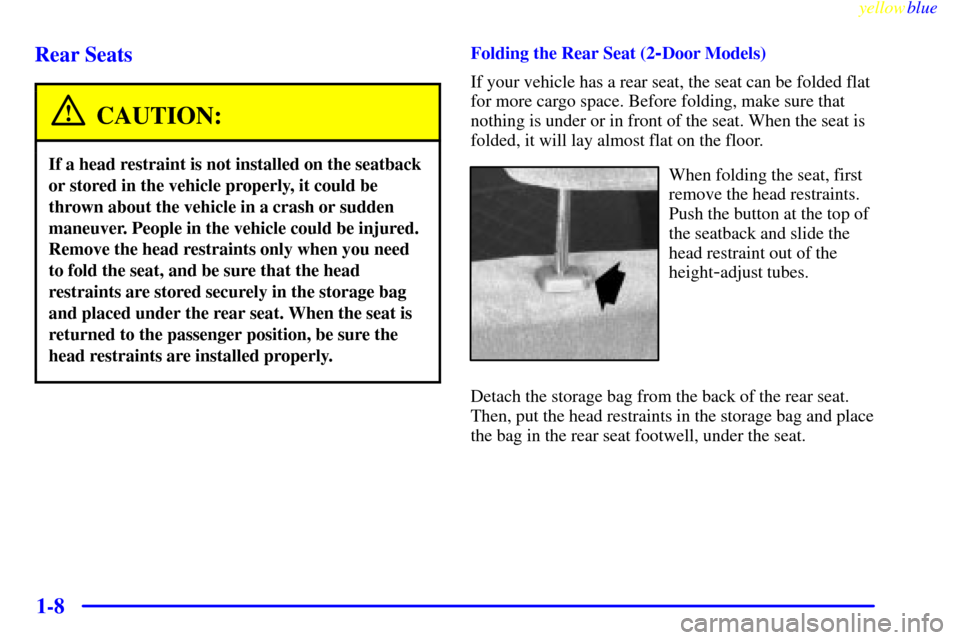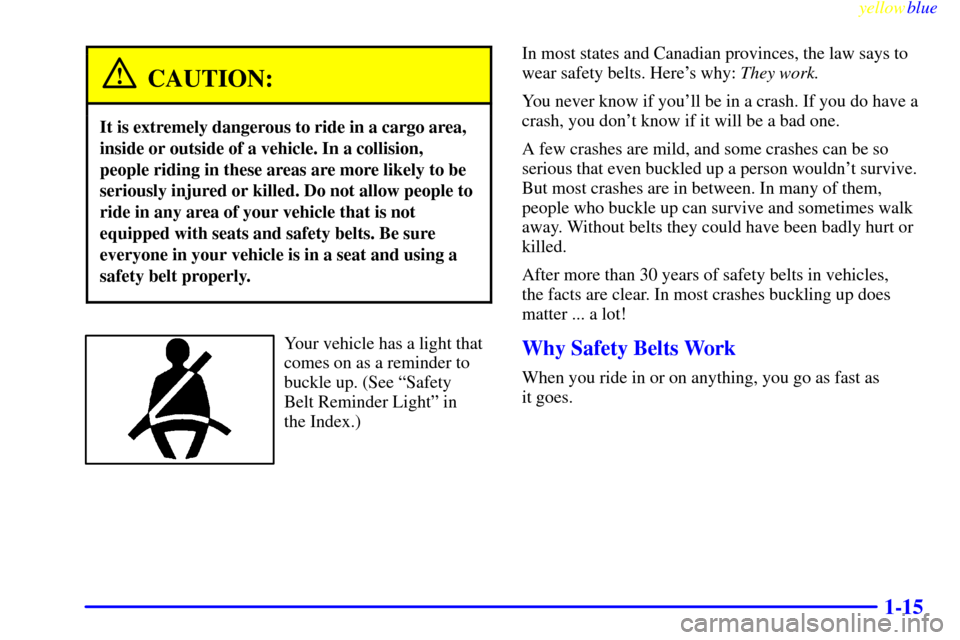Page 1 of 424

yellowblue
i
The 1999 Chevrolet Tahoe and Suburban Owner's Manual
1-1 Seats and Restraint SystemsThis section tells you how to use your seats and safety belts properly. It also explains the air bag system.
2-1 Features and ControlsThis section explains how to start and operate your vehicle.
3-1 Comfort Controls and Audio SystemsThis section tells you how to adjust the ventilation and comfort controls and how to operate your audio system.
4-1 Your Driving and the RoadHere you'll find helpful information and tips about the road and how to drive under different conditions.
5-1 Problems on the RoadThis section tells you what to do if you have a problem while driving, such as a flat tire or overheated engine, etc.
6-1 Service and Appearance CareHere the manual tells you how to keep your vehicle running properly and looking good.
7-1 Maintenance ScheduleThis section tells you when to perform vehicle maintenance and what fluids and lubricants to use.
8-1 Customer Assistance InformationThis section tells you how to contact Chevrolet for assistance and how to get service and owner publications.
It also gives you information on ªReporting Safety Defectsº on page 8-10.
9-1 IndexHere's an alphabetical listing of almost every subject in this manual. You can use it to quickly find
something you want to read.
Page 7 of 424
1-
yellowblue
1-1
Section 1 Seats and Restraint Systems
Here you'll find information about the seats in your vehicle and how to use your safety belts properly. You can also
learn about some things you should not do with air bags and safety belts.
1
-2 Seats and Seat Controls
1
-14 Safety Belts: They're for Everyone
1
-19 Here Are Questions Many People Ask About
Safety Belts
-- and the Answers
1
-20 How to Wear Safety Belts Properly
1
-20 Driver Position
1
-28 Safety Belt Use During Pregnancy
1
-29 Right Front Passenger Position
1
-29 Air Bag System
1
-36 Center Passenger Position1
-38 Rear Seat Passengers
1
-41 Rear Safety Belt Comfort Guides for Children
and Small Adults
1
-43 Children
1
-46 Child Restraints
1
-60 Larger Children
1
-63 Safety Belt Extender
1
-63 Checking Your Restraint Systems
1
-63 Replacing Restraint System Parts After
a Crash
Page 8 of 424
yellowblue
1-2
Seats and Seat Controls
This section tells you about the seats -- how to adjust
them and fold them up and down. It also tells you about
reclining front seatbacks and head restraints.
Manual Front Seat
CAUTION:
You can lose control of the vehicle if you try to
adjust a manual driver's seat while the vehicle is
moving. The sudden movement could startle and
confuse you, or make you push a pedal when you
don't want to. Adjust the driver's seat only when
the vehicle is not moving.
If your vehicle has a manual
bucket, split bench or full
bench seat, you can adjust it
with this lever at the front
of the seat.
Slide the lever at the front of the seat toward the
passenger's side to unlock it. Using your body, slide the
seat to where you want it. Then, release the lever and try
to move the seat with your body to make sure the seat is
locked into place.
Page 10 of 424
yellowblue
1-4 Heated Front Seats (If Equipped)
The control for the driver's side heated seat is located on
the left side of the seat. The control for the right front
passenger is located on the right side of the passenger's
seat. Move the switch forward to MED or HIGH
temperature to turn on the heating elements in the seat.
The right front passenger's safety belt must be buckled
before the heating elements in that seat will operate.
To turn the heated seats off, move the switch rearward
to OFF.
Reclining Front Seatbacks
To adjust the seatback, move the lever rearward.
Release the lever to lock the seatback where you want it.
Move the lever again rearward and the seatback will go
to an upright position.
Page 14 of 424

yellowblue
1-8 Rear Seats
CAUTION:
If a head restraint is not installed on the seatback
or stored in the vehicle properly, it could be
thrown about the vehicle in a crash or sudden
maneuver. People in the vehicle could be injured.
Remove the head restraints only when you need
to fold the seat, and be sure that the head
restraints are stored securely in the storage bag
and placed under the rear seat. When the seat is
returned to the passenger position, be sure the
head restraints are installed properly.
Folding the Rear Seat (2-Door Models)
If your vehicle has a rear seat, the seat can be folded flat
for more cargo space. Before folding, make sure that
nothing is under or in front of the seat. When the seat is
folded, it will lay almost flat on the floor.
When folding the seat, first
remove the head restraints.
Push the button at the top of
the seatback and slide the
head restraint out of the
height
-adjust tubes.
Detach the storage bag from the back of the rear seat.
Then, put the head restraints in the storage bag and place
the bag in the rear seat footwell, under the seat.
Page 16 of 424

yellowblue
1-10
Folding Rear Seats (4-Door Models)
The rear seat of the 4
-Door Utility or the second seat of
a Suburban may have a 60/40 seat, either side may be
folded down to give you more cargo space.
Before folding, place the latch portion of the center
safety belt in the center armrest. That way, the center
safety belt will be out of the way when the seat is folded
and also will be easily available for passengers to use
when the seat is returned to the passenger position. Also,
make sure that nothing is under or in front of the seat.
When the seat is folded, it will lay flat on the floor.
When folding the seat,
first remove the head
restraints. Push the release
buttons at the bottom of
each head restraint
height
-adjust post and slide
the head restraint out of the
height
-adjust tubes.
Set the head restraints aside for now. You will store
them in their proper position after you are done folding
the seat.
To fold the seat, pull up on
the strap loop at the rear of
the outer edge of the seat
cushion. Then, pull the
seat cushion up and fold
it forward.
After folding the seat cushion fully forward, pull the
seatback forward and fold the seatback down until it
is flat.
Then, store the head
restraints by sliding them
into the rear of the seat
cushion. Make sure the
posts go in all the way.
Page 21 of 424

yellowblue
1-15
CAUTION:
It is extremely dangerous to ride in a cargo area,
inside or outside of a vehicle. In a collision,
people riding in these areas are more likely to be
seriously injured or killed. Do not allow people to
ride in any area of your vehicle that is not
equipped with seats and safety belts. Be sure
everyone in your vehicle is in a seat and using a
safety belt properly.
Your vehicle has a light that
comes on as a reminder to
buckle up. (See ªSafety
Belt Reminder Lightº in
the Index.)In most states and Canadian provinces, the law says to
wear safety belts. Here's why: They work.
You never know if you'll be in a crash. If you do have a
crash, you don't know if it will be a bad one.
A few crashes are mild, and some crashes can be so
serious that even buckled up a person wouldn't survive.
But most crashes are in between. In many of them,
people who buckle up can survive and sometimes walk
away. Without belts they could have been badly hurt or
killed.
After more than 30 years of safety belts in vehicles,
the facts are clear. In most crashes buckling up does
matter ... a lot!Why Safety Belts Work
When you ride in or on anything, you go as fast as
it goes.
Page 26 of 424

yellowblue
1-20
How to Wear Safety Belts Properly
Adults
This part is only for people of adult size.
Be aware that there are special things to know about safety
belts and children. And there are different rules for smaller
children and babies. If a child will be riding in your
vehicle, see the part of this manual called ªChildren.º
Follow those rules for everyone's protection.
First, you'll want to know which restraint systems your
vehicle has.
We'll start with the driver position.
Driver Position
This part describes the driver's restraint system.
Lap-Shoulder Belt
The driver has a lap-shoulder belt. Here's how to wear
it properly.
1. Close and lock the door.
2. Adjust the seat (to see how, see ªSeatsº in the Index)
so you can sit up straight.
3. Pick up the latch plate and pull the belt across you.
Don't let it get twisted.
4. Push the latch plate into the buckle until it clicks.
Pull up on the latch plate to make sure it is secure.
If the belt isn't long enough, see ªSafety Belt
Extenderº at the end of this section.
Make sure the release button on the buckle is positioned
so you would be able to unbuckle the safety belt quickly
if you ever had to.